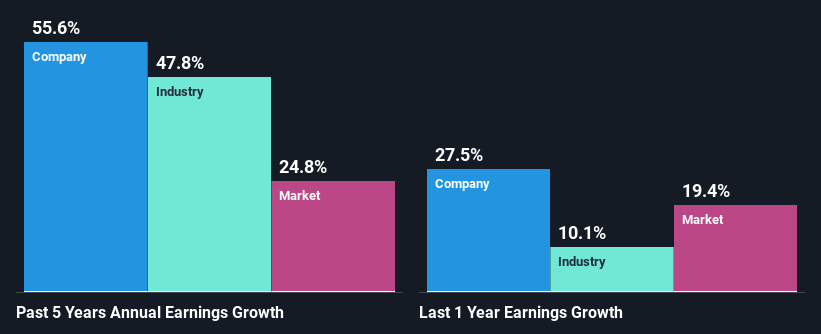- India
- /
- Hospitality
- /
- NSEI:THOMASCOOK
Declining Stock and Decent Financials: Is The Market Wrong About Thomas Cook (India) Limited (NSE:THOMASCOOK)?
With its stock down 13% over the past three months, it is easy to disregard Thomas Cook (India) (NSE:THOMASCOOK). But if you pay close attention, you might find that its key financial indicators look quite decent, which could mean that the stock could potentially rise in the long-term given how markets usually reward more resilient long-term fundamentals. Specifically, we decided to study Thomas Cook (India)'s ROE in this article.
Return on equity or ROE is a key measure used to assess how efficiently a company's management is utilizing the company's capital. In short, ROE shows the profit each dollar generates with respect to its shareholder investments.
Our free stock report includes 2 warning signs investors should be aware of before investing in Thomas Cook (India). Read for free now.How To Calculate Return On Equity?
ROE can be calculated by using the formula:
Return on Equity = Net Profit (from continuing operations) ÷ Shareholders' Equity
So, based on the above formula, the ROE for Thomas Cook (India) is:
12% = ₹2.5b ÷ ₹21b (Based on the trailing twelve months to December 2024).
The 'return' is the amount earned after tax over the last twelve months. So, this means that for every ₹1 of its shareholder's investments, the company generates a profit of ₹0.12.
See our latest analysis for Thomas Cook (India)
What Is The Relationship Between ROE And Earnings Growth?
So far, we've learned that ROE is a measure of a company's profitability. Depending on how much of these profits the company reinvests or "retains", and how effectively it does so, we are then able to assess a company’s earnings growth potential. Generally speaking, other things being equal, firms with a high return on equity and profit retention, have a higher growth rate than firms that don’t share these attributes.
A Side By Side comparison of Thomas Cook (India)'s Earnings Growth And 12% ROE
On the face of it, Thomas Cook (India)'s ROE is not much to talk about. However, its ROE is similar to the industry average of 10%, so we won't completely dismiss the company. Looking at Thomas Cook (India)'s exceptional 56% five-year net income growth in particular, we are definitely impressed. Taking into consideration that the ROE is not particularly high, we reckon that there could also be other factors at play which could be influencing the company's growth. For instance, the company has a low payout ratio or is being managed efficiently.
We then performed a comparison between Thomas Cook (India)'s net income growth with the industry, which revealed that the company's growth is similar to the average industry growth of 48% in the same 5-year period.

Earnings growth is a huge factor in stock valuation. What investors need to determine next is if the expected earnings growth, or the lack of it, is already built into the share price. Doing so will help them establish if the stock's future looks promising or ominous. What is THOMASCOOK worth today? The intrinsic value infographic in our free research report helps visualize whether THOMASCOOK is currently mispriced by the market.
Is Thomas Cook (India) Efficiently Re-investing Its Profits?
Thomas Cook (India) has a really low three-year median payout ratio of 16%, meaning that it has the remaining 84% left over to reinvest into its business. This suggests that the management is reinvesting most of the profits to grow the business as evidenced by the growth seen by the company.
Besides, Thomas Cook (India) has been paying dividends for at least ten years or more. This shows that the company is committed to sharing profits with its shareholders. Existing analyst estimates suggest that the company's future payout ratio is expected to drop to 11% over the next three years. As a result, the expected drop in Thomas Cook (India)'s payout ratio explains the anticipated rise in the company's future ROE to 19%, over the same period.
Summary
On the whole, we do feel that Thomas Cook (India) has some positive attributes. With a high rate of reinvestment, albeit at a low ROE, the company has managed to see a considerable growth in its earnings. With that said, the latest industry analyst forecasts reveal that the company's earnings growth is expected to slow down. To know more about the latest analysts predictions for the company, check out this visualization of analyst forecasts for the company.
Valuation is complex, but we're here to simplify it.
Discover if Thomas Cook (India) might be undervalued or overvalued with our detailed analysis, featuring fair value estimates, potential risks, dividends, insider trades, and its financial condition.
Access Free AnalysisHave feedback on this article? Concerned about the content? Get in touch with us directly. Alternatively, email editorial-team (at) simplywallst.com.
This article by Simply Wall St is general in nature. We provide commentary based on historical data and analyst forecasts only using an unbiased methodology and our articles are not intended to be financial advice. It does not constitute a recommendation to buy or sell any stock, and does not take account of your objectives, or your financial situation. We aim to bring you long-term focused analysis driven by fundamental data. Note that our analysis may not factor in the latest price-sensitive company announcements or qualitative material. Simply Wall St has no position in any stocks mentioned.
About NSEI:THOMASCOOK
Thomas Cook (India)
Offers integrated travel services in India and internationally.
Excellent balance sheet with reasonable growth potential.
Similar Companies
Market Insights
Community Narratives



